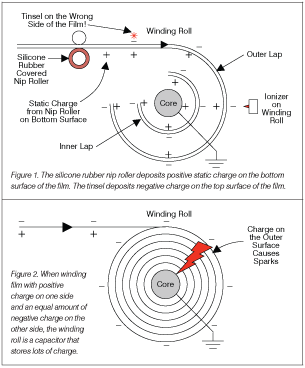How To Prevent Winding Roll Sparks
- Published: July 01, 2009, By By Dr. Kelly Robinson Contributing Editor
Our goal is to produce and ship product with no static charge. Zero. Zip. None.
Achieving this goal is difficult and costly. Realistically, we need to keep static levels low enough so our customers order more of our stuff.
Static sparks on winding rolls are common and raise a big red flag that the winding roll has static so high our customers will complain. Sparks can cause sheets to stick and jam, damage the surface of products, attract dust, cause logic problems for machine control systems, and injure operators.
To eliminate sparks on the winding roll, the “quick and dirty” answer is to add more tinsel to the film path until the sparks stop. And, if nothing else works, install an ionizer to discharge with the winding roll.
Even though the ionizer on the winding roll will effectively stop the sparks, the roll likely will have high static when our customers unwind it. Let's take a closer look and see how to solve the problem of sparking on a winding roll.
One important cause of sparks on winding rolls shown in Figure 1 is tinsel that has been installed on the wrong side of the film. In this example, the film touches the silicone rubber nip roller so the bottom surface of the film has positive static charge. The tinsel just downstream of the nip roller sees this positive static and generates negative charge, which deposits on the top surface of the film. The result is film with positive charge on one surface and an equal amount of negative charge on the other surface.

With no ionizer on the winding roll, this tinsel does not solve the problem. Sparks fly when winding this charged film! The root cause, illustrated in Figure 1, is that positive charge on the outer lap is balanced by the negative charge on the inner lap. On each lap within the roll, charge is balanced all the way down to the core. However, charge on the outside surface of the winding roll is not balanced.
Figure 2 shows that when winding this charged film, the roll is a capacitor that stores charge on its outer surface. This charge causes the sparks.
The best solution is to move the tinsel to the proper side of the film, so the negative charge from the tinsel deposits on the same surface that has the positive charge from the silicone rubber nip roller. When adding tinsel to your film path, it is very important to position the tinsel so it faces the charged surface of the film. Sparks fly when tinsel is on the wrong side!
Adding an ionizer facing the winding roll is a poor way to eliminate sparks. This ionizer will effectively stop the sparking by depositing additional positive charge on the winding roll. However, this ionizer adds even more charge to the winding roll, and all of the charge will be delivered to the customer. When the roll is unwound in the customer's application, the roll will be “hot” and exhibit high levels of static.
To eliminate sparks on a winding roll, find the source of the static on the film. Locate the tinsel just downstream of the charging source and position the tinsel so it faces the side of the film that is charged. It is a good practice to use an ionizer on the winding roll because it does protect your operators and your equipment. Just be sure it doesn't have to work overtime because you may have other problems that inspire your customers to look for other suppliers!
Static control expert Dr. Kelly Robinson, president of Electrostatic Answers, has 27+ years of experience in problem-solving and consulting. Contact him at 585-425-8158; This email address is being protected from spambots. You need JavaScript enabled to view it.; www.electrostaticanswers.com.




